Prior to my visit to Daufuskie Island in South Carolina, the extent of my knowledge of the low country was limited to the sultry narratives of writer Pat Conroy and brief visits to Savannah, Georgia, and Charleston, South Carolina.
My low-country awareness was significantly enhanced after accepting an invitation to visit the private community of Haig Point, which covers 1,050 acres of the historic, bridgeless island. As a die-hard northerner, I wasn’t expecting to be mesmerized by the seductive beauty and rich culture of the area quite so quickly. To experience portions of the island on horseback was an added bonus.
After an easy flight to Savannah, I was whisked to the Haig Point embarkation center, where I was amiably greeted by Adam Martin, Haig Point’s director of sales and marketing. Adam took full advantage of the 45-minute ferry ride from Hilton Head Island to the community’s landing point to familiarize me with Haig Point’s geographic setting, the surrounding bodies of water, and a descriptive overview of the private, member-owned community.
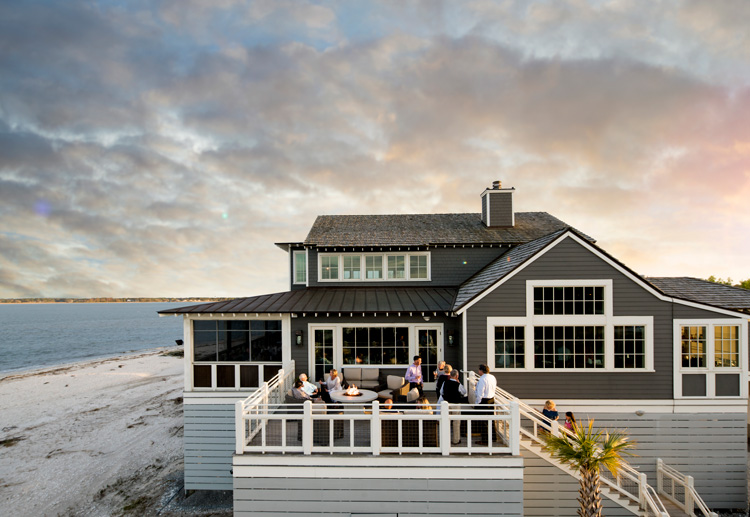
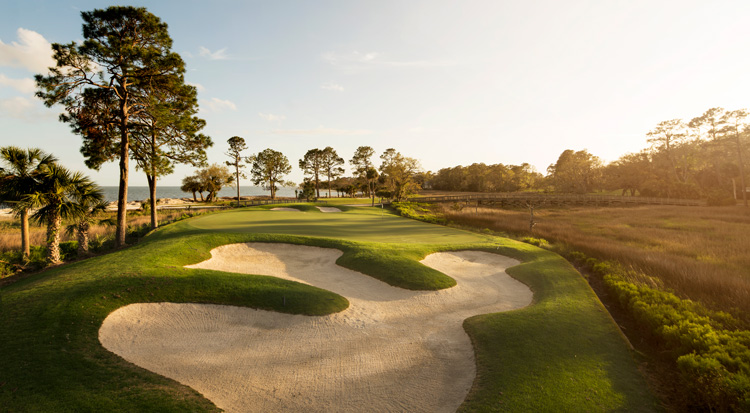
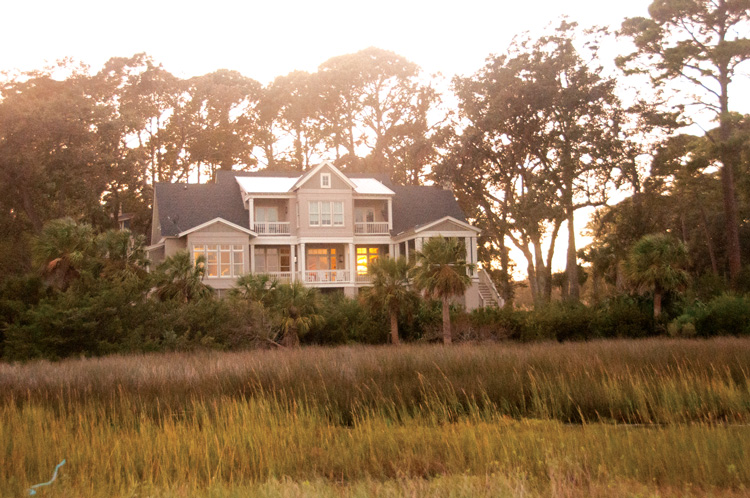
Members can enjoy an array of activities and amenities here, including an award-winning tennis center, multiple golf courses suited for both highly skilled and recreational golfers, a fitness center, a community park, a thriving equestrian center where I spent a great deal of time, and a range of dining venues. While enjoying a plethora of facilities and sophisticated services, the members are also committed to integrating and preserving the rustic character and rich history of the island.
The Strachan Mansion, located at Haig Point’s landing, serves as the community center, where coffee, baked goods, and newspapers are available for members and guests. Originally built in 1910, the mansion was barged over from the mainland in pieces, then updated and restored to its original grandeur. It features four suites available for residents’ guests or those enjoying Haig Point’s discovery experience. Adjacent to the mansion are the community-preserved tabby ruins, the remnants of slave’s quarters ingeniously built with a mix of oyster shells, sand, and lime.

My accommodations were in the historic, and still functioning, 1873 lighthouse that was restored in the 1980s. I comfortably settled into an ample two-bedroom house replete with kitchen, dining and living rooms, and spacious porch overlooking the Calibogue Sound. Each night, lapping waves along the shore and softly clanking halyards on the lighthouse flagpole lulled me into peaceful slumber. However, I wasn’t expecting to share the house with a ghost. As the legend goes, a young maiden named Maggie lived in the lighthouse in the late 1800s. She fell in love with a naval engineer who serviced the lighthouse’s lantern room. But their love was not to be. The engineer left and never returned to Daufuskie Island, leaving her with a broken heart. I’m not a particularly superstitious person, so I viewed the legend as balderdash and quickly put Maggie out of my mind.
A full itinerary had been arranged for my three-day visit, which included daily rides and events at the equestrian center. Once again, Adam launched me into my tour by providing me with my personal golf cart (the sole mode of transportation in Haig Point), a map of the community and island, and a quick loop around the lay of the land that conveniently deposited me at the equestrian center.

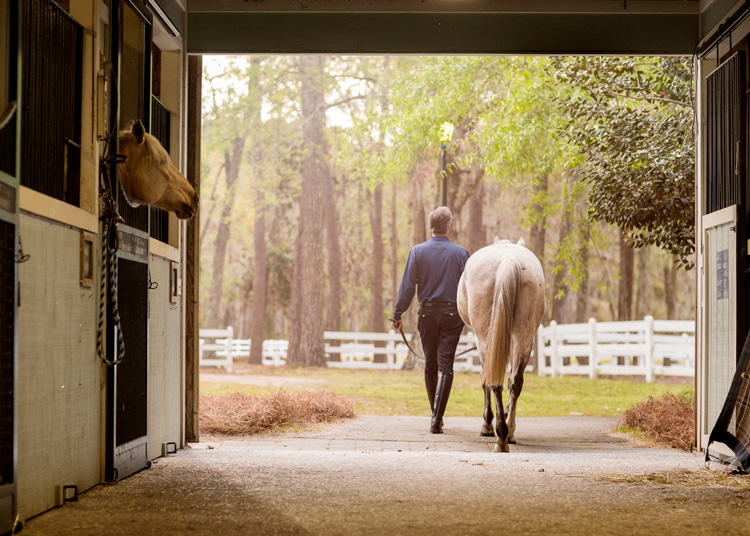 What a welcoming sight. Slightly off the beaten path, the 18-stall barn and paddocks are shaded in dappled light, and healthy horses graze beneath a canopy of resilient live oaks. Rachel Allen, the equestrian director, has purposely created an organized and inviting barn environment, where members are inspired to come, take lessons, socialize, and hang out. “Who wouldn’t want to go to the barn?” Rachel laughed. “The thought is foreign to me.” I experienced the barn camaraderie after joining several Haig Point members on a ride-and-wine hack through the lush property that offered sightings of osprey nests, white-tailed deer, and a small, marshside alligator basking in the sun. Following our ride, we enjoyed wine, antipasto, and animated conversation in the barn lounge, where the topic of Maggie the ghost surfaced once again, however I was lightheartedly reassured that she was friendly.
What a welcoming sight. Slightly off the beaten path, the 18-stall barn and paddocks are shaded in dappled light, and healthy horses graze beneath a canopy of resilient live oaks. Rachel Allen, the equestrian director, has purposely created an organized and inviting barn environment, where members are inspired to come, take lessons, socialize, and hang out. “Who wouldn’t want to go to the barn?” Rachel laughed. “The thought is foreign to me.” I experienced the barn camaraderie after joining several Haig Point members on a ride-and-wine hack through the lush property that offered sightings of osprey nests, white-tailed deer, and a small, marshside alligator basking in the sun. Following our ride, we enjoyed wine, antipasto, and animated conversation in the barn lounge, where the topic of Maggie the ghost surfaced once again, however I was lightheartedly reassured that she was friendly.
Events such as a fall barbecue and pig roast, a deck-the-stalls competition, and a derby day are hosted at the barn throughout the year. “One of our members loves being a bookie at our derby-day event,” smiled Rachel. “People were betting actual money, and the leftover funds went toward adopting three Thoroughbreds from Old Friends Farm in Kentucky. We pay the adoption fees. It’s paying it forward.”
Before I set out on my beach ride the following day, I had the chance to have a traditional low-country lunch at Lucy Bell’s Cafe with Rachel and her barn manager, Jody Smith. The growth of the equestrian center is their primary focus. “Expanding our paddocks and adding an indoor or a covered arena with lights would allow us to work at different times of the day,” said Rachel. “We have already been granted a few lots for newer paddocks in 2018.
“The other long-term vision is to acquire a secondary location that could be a public end of the business,” Rachel mused. “It is a beautiful property that has been sitting idle for quite some time. We could have access to a 12-stall barn and multiple riding arenas, and it’s only a 10-minute walk to the most beautiful beach on the island. There are very few beach riding opportunities left on the East Coast, and for many riders, it’s a bucket-list item.”
Shortly after my visit, I learned that a portion of Rachel’s vision was realized as Haig Point established a secondary operation called Daufuskie Island Trail Rides at the formerly idle neighboring barn. It will be the only public stable on the island, offering beach and trail rides to the general public.
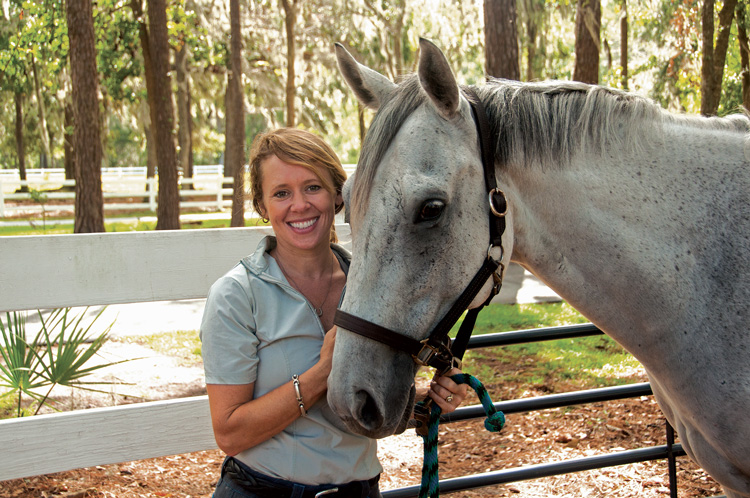
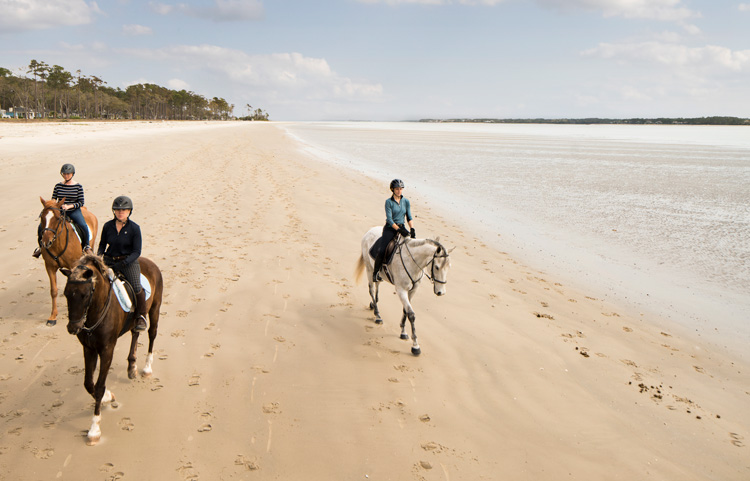 Rachel and Jody have noticed a significant increase in lessons. “Not just individuals but entire families are attracted to the Haig Point lifestyle,” explained Rachel. “Younger families are coming in, and the equestrian center is a huge part of that. When I first started, there were two or three regular lessons, and now I have 20. It’s kids, moms and dads, and people riding at later stages of their lives.” Jody added, “We are trying to diversify and offer a broad spectrum to capture an all-inclusive audience.”
Rachel and Jody have noticed a significant increase in lessons. “Not just individuals but entire families are attracted to the Haig Point lifestyle,” explained Rachel. “Younger families are coming in, and the equestrian center is a huge part of that. When I first started, there were two or three regular lessons, and now I have 20. It’s kids, moms and dads, and people riding at later stages of their lives.” Jody added, “We are trying to diversify and offer a broad spectrum to capture an all-inclusive audience.”
For equestrians, Haig Point has a unique advantage. You can ride on the beach and most of the island all year. There are very few cars and virtually no traffic. To put things in perspective, at the time of my visit there was only one gas pump on the entire island.
An opportunity to ride on an expansive, empty beach is typically an ultimate luxury. Unfortunately, the day of my ride was extremely windy with sand whipping erratically and not ideal for me or my horse, which had already spooked on one too many occasions. Instead, Jody led us along miles of quiet roads and lush wooded trails that were more to my mount’s liking. My legs were wobbly by the end of our five-mile ride, but after dismounting and stretching I was good to go.
Each time I left the barn I took a different route back to the lighthouse, navigating my golf cart under tall oaks laden with shimmering Spanish moss and over wooden bridges that crisscrossed the ubiquitous swaying marsh grasses, tipped with light from the setting sun. The homes, most reflecting distinctive low-county architecture, are tucked into quiet settings and landscaped with native plants. My tours were incredibly quiet. There were no sirens, honking, or any of the daily sounds that barrage most of us who don’t live on a bridgeless island.
An island of contradictions continued to surface in amazing ways. Spontaneity would seem difficult, as there are minimal services on the island. Members have to ferry to the mainland for shopping, appointments, and day-to-day errands, but the ferries are frequent and run as efficiently as a Swiss watch. People actually enjoy the trip and use the 45 minutes to read, visit with neighbors, or catch up on work. “Daufuskie has to appeal to pioneering people who are willing to have a trade-off,” Rachel explained. “It’s the price of paradise. If you want to live in paradise, it’s going to cost you something.”
On my last morning I took a private lesson with Rachel, and I experienced firsthand her eye for conformation and a keen ability to correct a body out of alignment. If I had had more time, my riding would have improved exponentially.
Following my lesson, I was scheduled to have a waterside lunch at Old Daufuskie Crab Company with Erica (Evie) Veit, the founder and director the Daufuskie Marsh Tacky Society, a 501(c3) nonprofit founded in 2015. The goal of the society is to promote and protect the critically endangered marsh tacky horse. “We are trying to expand the breed, and our vision is to ensure that future generations can enjoy these horses without the threat of becoming extinct,” said Evie.

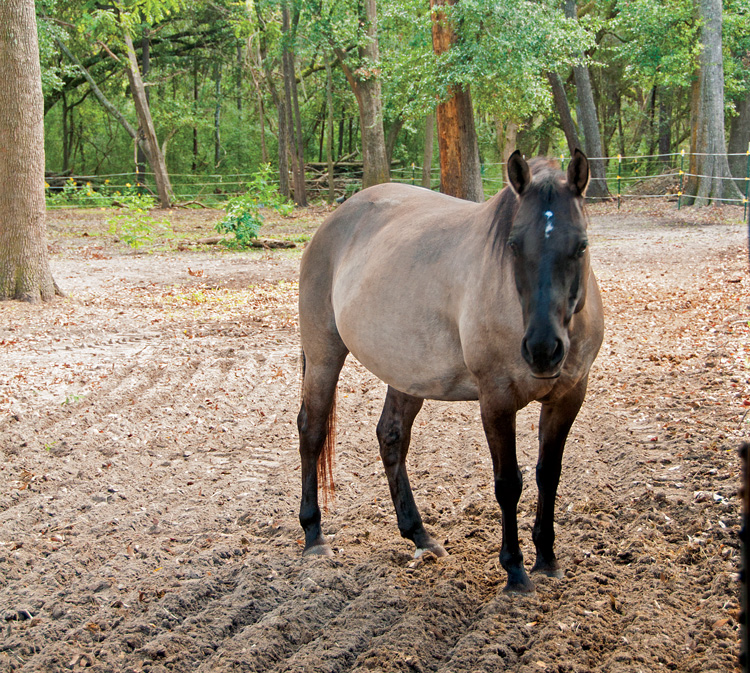
Brought over in the 1500s during the Golden Age of Spain, marsh tackies were considered to be expendable and able to survive on the smallest of rations in the cargo holds of ships. They were prized for being rugged, hardy horses adaptable to the swampy, hot, and muggy conditions of the barrier islands.
There are now only 420 of the breed in existence, and all are in the U.S. Their bloodline is thought to be completely extinct in Europe. The Carolina Marsh Tacky Association keeps the official breeding records.
“I currently have four horses that include a 2-year-old stallion who has been bred with a brood mare who will foal shortly,” Evie revealed. “This will be the first marsh tacky foal born on Daufuskie in possibly 30 to 40 years.” In an effort to bring more awareness and appreciation of the breed, Evie hosts and participates in countless fundraising events to support her mission.
With my time waning, I said my goodbye to Evie and headed to the Daufuskie Community Farm and Artisan’s Village, the island’s sustainable and organic farm started in 2010 by Pat Beichler and supported by community volunteers. The original plot, purchased for one dollar, was dense forest and cleared by Pat and hardy volunteers. Scattered with whimsical buildings and barns, the farm has expanded from solely animals to gardens, orchards, and the new artisan’s village.
What I truly savor on these kinds of visits is the time spent with local residents. Natives, if you will. They are the source of the true nature of a place. Often emerging over a delicious meal and a glass of wine, the essence of a place flows freely. I was fortunate enough to share an enjoyable meal with Haig Point’s CEO, Doug Egly and his wife, Nancy, at CQ’s in vibrant Harbour Town on Hilton Head. They both claimed they would never leave, and I believed them. The following evening, I dined at Haig Point’s waterfront Calibogue Club with residents Kate and Jim Woodward, who mentioned their teenage granddaughter had moved in with them because she loved riding and the equestrian center. As a result, Kate, an avid tennis player, started riding, and Jim began carriage-driving lessons.
Chef Jim McLain (see EQLiving December/January 2017/2018) served up truly memorable meals on each occasion I dined at a Haig Point venue, plying me with innovative creations incorporating lobster, lump crab, or filet mignon.
On my final evening I planned to eat at the lighthouse. Chef Jim suggested I pick up a dinner from the Calibogue Club at 7:00 p.m. I followed the waterfront path to the club, passing a small herd of deer as dusk was beginning to fade.
It was dark by the time I got back to the lighthouse. I opened the door and was unnerved to hear music wafting quietly through the house. I looked upstairs and downstairs, and nothing was switched on. No television. No radio. No computer. I will admit to thinking Maggie must have been the source. Then, off in the distance, I spotted a party boat drifting by.
See:
daufuskiemarshtackysociety.com